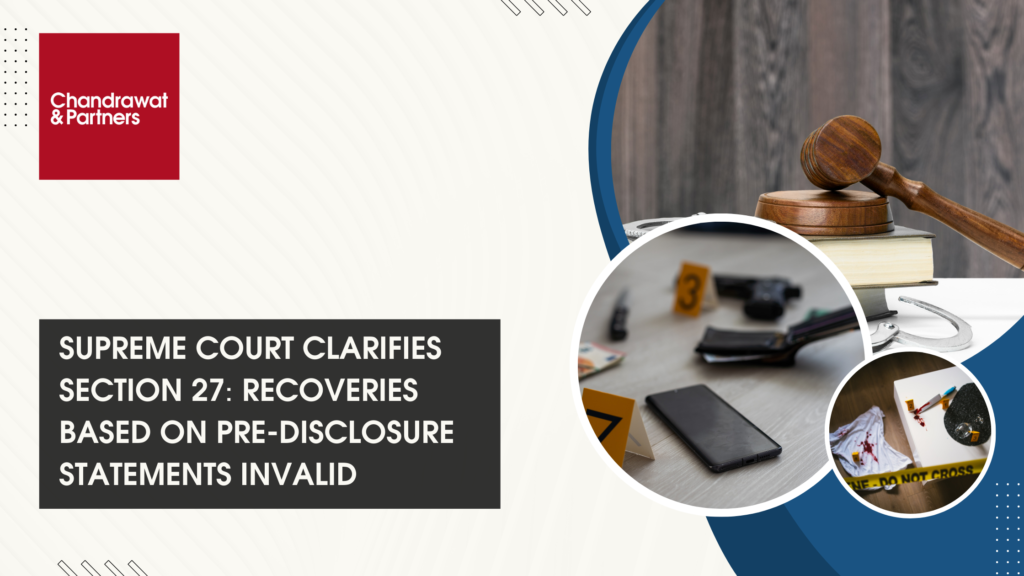Home > Recent Judgements > Supreme Court Clarifies Section 27: Recoveries Based On Pre-Disclosure Statements Invalid
DEC 02, 2024

BACKGROUND
In the case of Suresh Chandra Tiwari & Anr. Versus State of Uttarakhand, this appeal challenges the conviction for murder of the accused persons with respect to the claim of recovery of some incriminating materials in connection with the purported recovery statement made under section 27 of the Indian Evidence Act, 1872. The recovery, however, was completed on the way to the police station even before the disclosure was recorded at the station. The accused persons contended that this recovery which has been termed as chance recovery, under section 27, failed to satisfy the conditions of admissibility. Here, too, the court agreed with the appellant, where the failure of prosecution case was recognized as and at the time of trial all evidence was brought. The misconduct of the appellant’s counsel was emphasized in the recovery of three claim witnesses and unsigned premises recovery papers, as well as other inconsistencies surrounding the chain of events. Hence, the Supreme Court had the position that the conviction cannot be rated due to non – compliance, more like abuse of circumstances with regards to incorporation of section 27.
UNDERSTANDING THE SECTION 27 OF EVIDENCE ACT AND SECTION 304 OF IPC
Section 27 of Evidence Act– When any fact is deposed to as discovered in consequence of information received from a person “accused of any offence, in the custody of a police officer, so much of such information, whether it amounts to a confession or not, as relates distinctly to the fact thereby discovered, may be proved.
ISSUES
- Whether the recovery of incriminating materials en route to the police station before the recording of a disclosure statement under Section 27 of the Indian Evidence Act is admissible as evidence?
- Whether the alleged recovery made before the formal recording of a disclosure statement qualifies as “discovery of fact” under Section 27 of the Indian Evidence Act?
- Whether the alleged recovery can be classified as a “chance recovery” and if such classification impacts its admissibility under the law?
- Whether the prosecution proved the entire chain of circumstantial evidence beyond a reasonable doubt?
CIRCUMSTANTIAL EVIDENCE
The circumstances from which the conclusion of guilt is to be drawn should be fully established.
- the circumstances should be of a definite tendency unerringly pointing towards the guilt of the accused.
- the circumstances taken cumulatively should form a chain so far complete that there is no escape from the conclusion that within all human probability the crime was committed by the accused.
- the circumstances should be consistent only with the hypothesis regarding the guilt of the accused;
- they must exclude every possible hypothesis except the one which is sought to be proved. In a case based on circumstantial evidence where two views are possible, one pointing to the guilt and the other to his innocence, the accused is entitled to the benefit of one which is favorable to him- the mental distance between ‘may be’ and ‘must be’ is long and divides vague conjectures from sure conclusions. Therefore, even if the prosecution evidence generates strong suspicion against the accused, it cannot be a substitute for proof.
JUDGEMENT
Supreme Court has held that a disclosure statement is not admissible in evidence if the alleged discovery was not made accordance to that statement. By confirming that the recovery of the murder weapon constituted a crucial and acceptable piece of evidence under Section 27, the Supreme Court maintained the convictions. But it also warned that when using Section 27, investigators and courts must strictly adhere to procedural and constitutional protections.
OBSERVATION
The disclosure statement of an accused person is not admissible in evidence in its entirety. Only the portion of the statement that directly led to the discovery of a specific fact is admissible. The prosecution must establish a clear link between the information provided and the fact discovered. The court must be cautious in applying Section 27 to avoid misuse and ensure that the evidence is credible.
For more information or queries, please email us at
enquiries@chandrawatpartners.com




